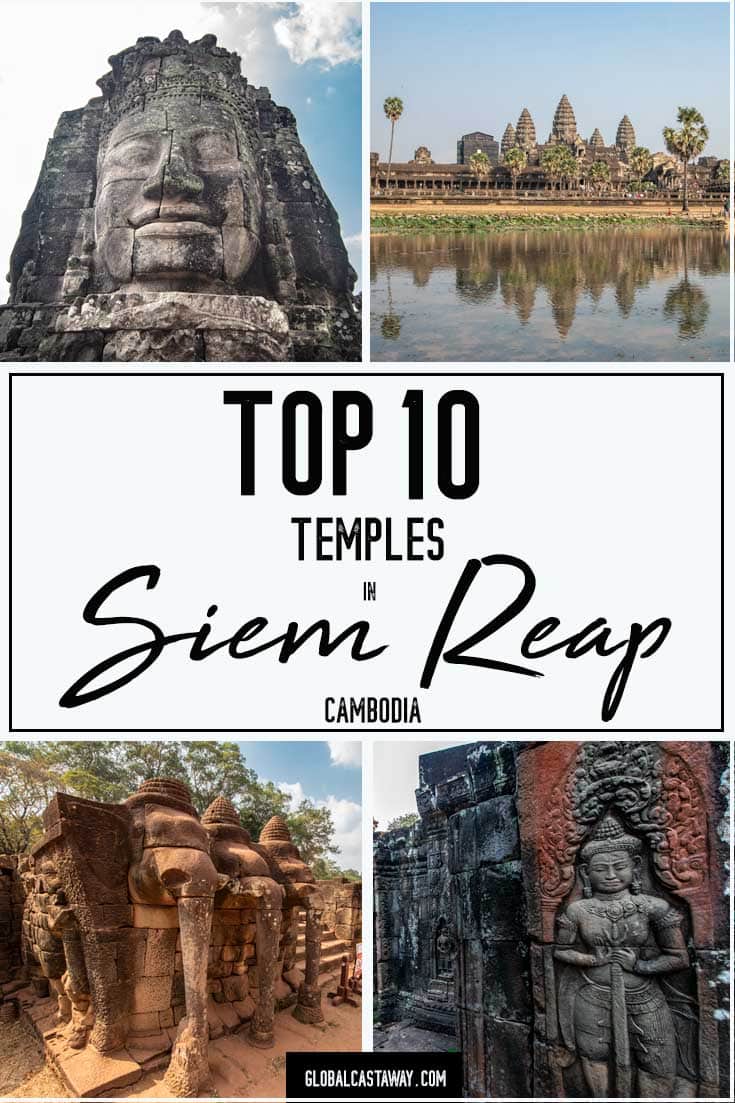I have to confess something, a while ago I wasn’t even aware of the existence of the Siem Reap temples. I’ve always imagined Angor Wat as a single temple, and it didn’t even occur to me there may be more of its kind. Imagine my surprise when I began researching Cambodia and found out Angkor Wat is just one of the 50 remaining Buddhist and Hindu temples in Siem Reap.
Unless you’re planning a month-long trip there, you probably won’t have enough time to see them all so to help things out, I decided to make a list of the 10 best Siem Reap temples.
Even though they are ranked from least exciting to a must-see bucket list experience, I strongly recommend paying a visit to all of them. Each temple has a charm of its own, and I can guarantee it won’t be a waste of time!
10. Phnom Bakheng

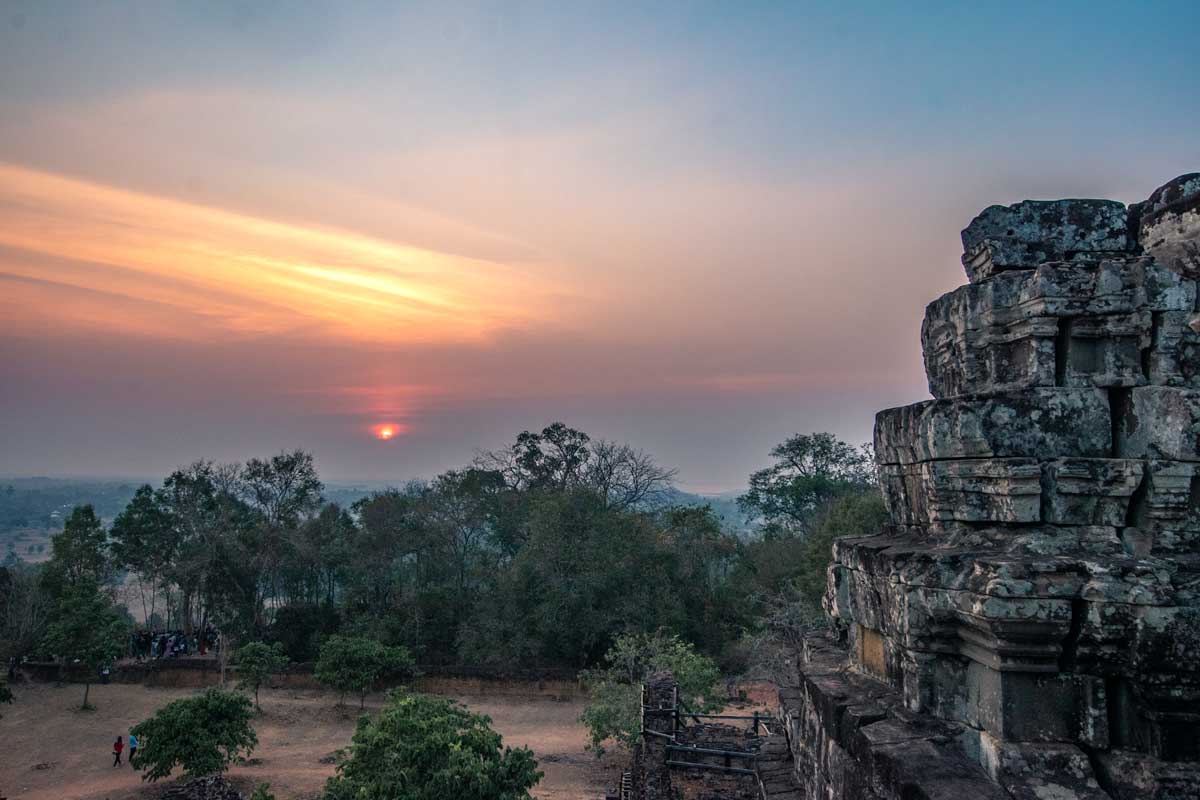
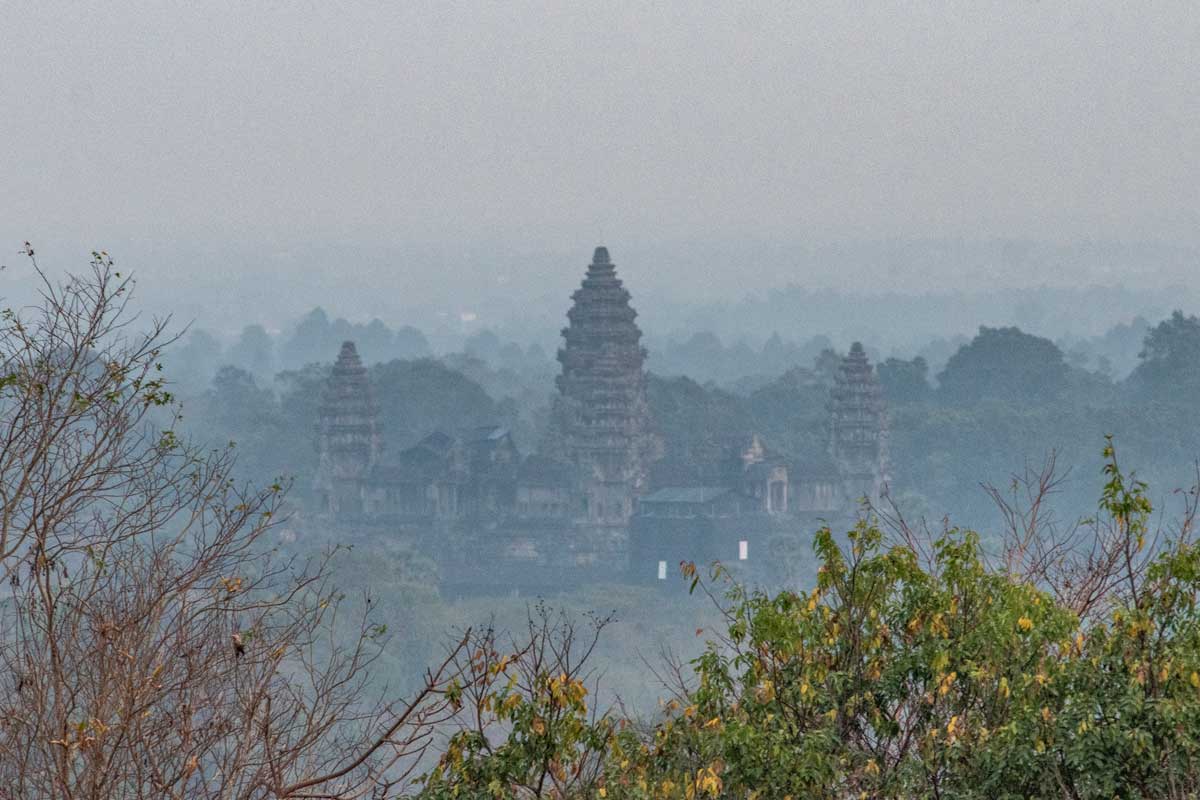
Built at the end of the 9th century, more than 200 years before Angkor Wat, Phnom Bakheng used to be the principal temple of the area. Due to its location on top of a hill, nowadays it’s the most popular temple in Siem Reap to catch the sunset at.
Phnom Bakheng is built to honor and represent Mount Meru – the home of the Hindu gods (that’s why it’s on top of a hill). It is structured in a pyramid form of 7 layers, each symbolizing one of the seven heavens.
From the upper terrace of the temple, you get an incredible panoramic view of the dense Cambodian jungle and Angkor Wat in the distance.
Castaway Tip
Since the temple is a trendy sunset spot, only 300 people are allowed to be at Phnom Bakheng at the same time. If you want to make sure you are one of them, be there at least 2 hours before sunset.
9. Ta Keo



Ta Keo is one of the tallest monuments in the Angkor Archeological Park. It was built in the 11th century by King Jayavarman V, and it represents Mount Meru (yup, the Khmers were big fans of Mount Meru). The shape of the temple is a 22 meters high, five-layered pyramid with five sanctuaries on top. Sadly, the building project was abandoned before the temple was finished, so the monument lacks any detailed ornaments.
The legend has it that lightning struck Ta Keo and this was interpreted as a bad omen by the Khmers, so they abandoned it.
While the views at the top are not as good as the ones at Phnom Bakheng, the adventure of climbing 20 meters of tiny Khmer steps, earns Ta Keo 9th place on my Top 10 Best Siem Reap Temples list.
See Also: Top 15 Historical Places in The World
8. East Mebon
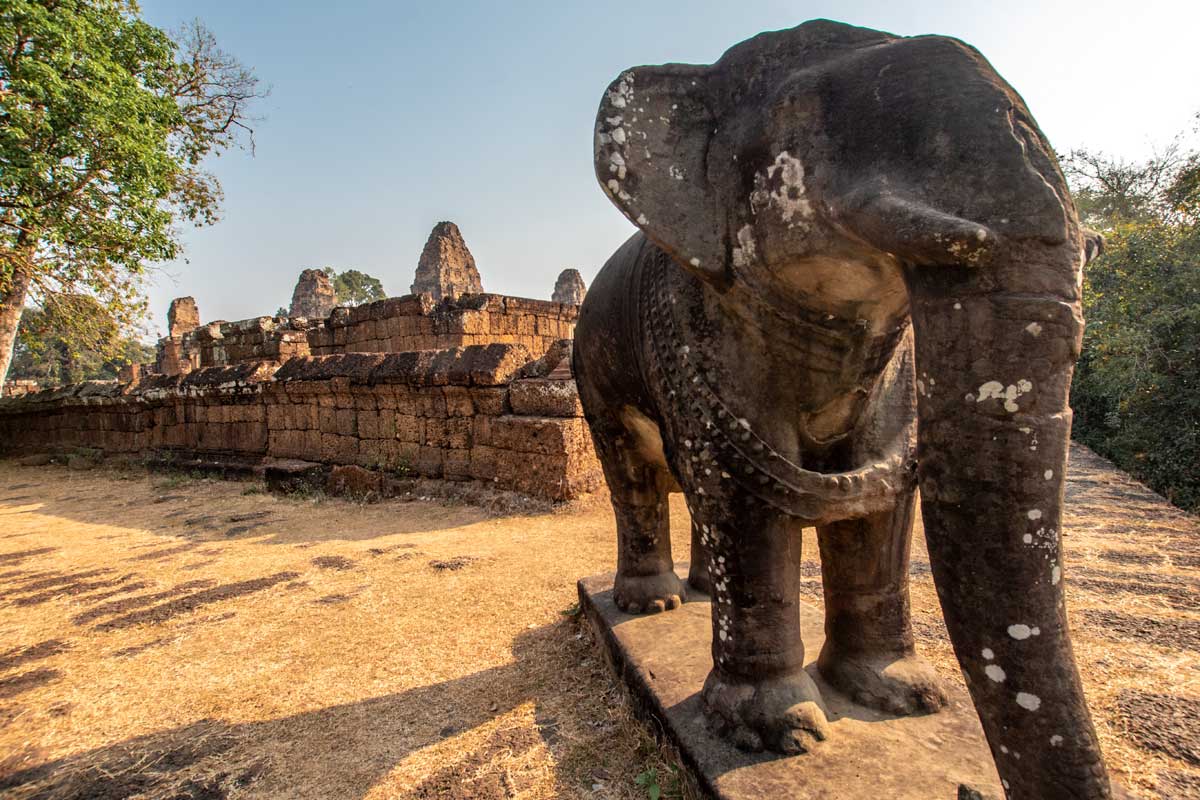
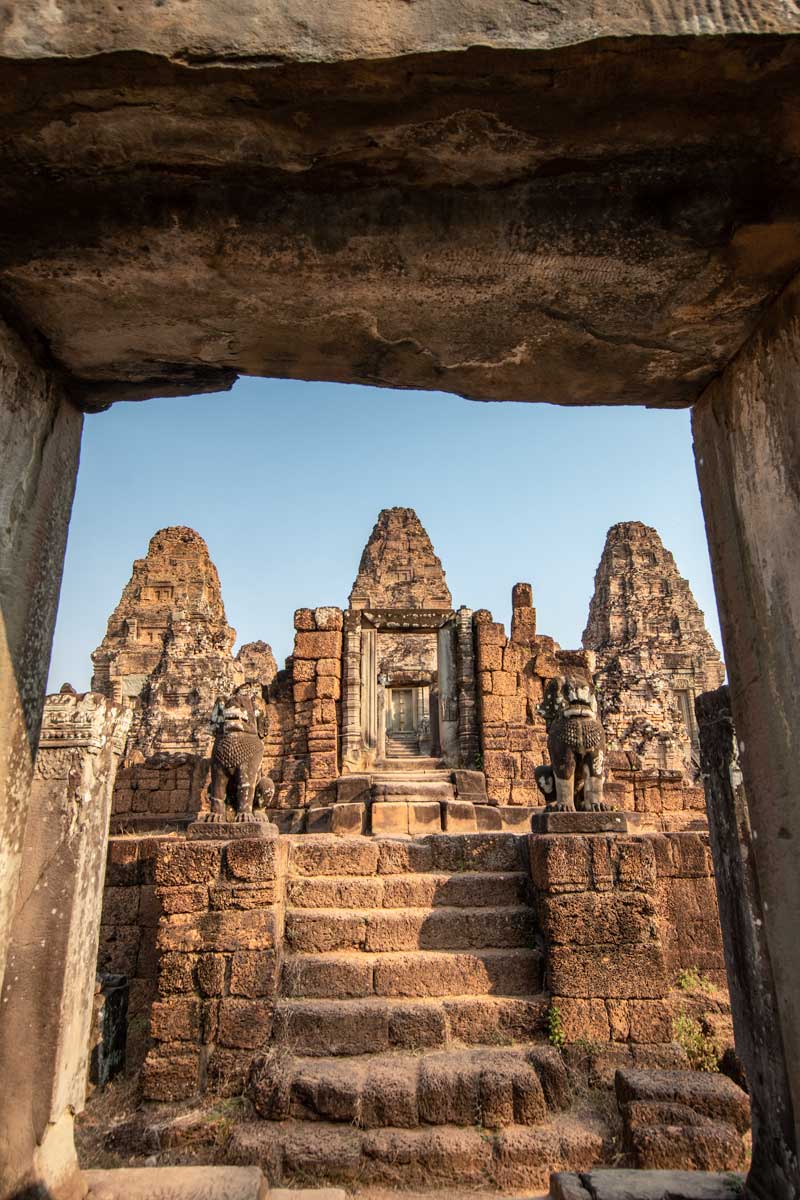
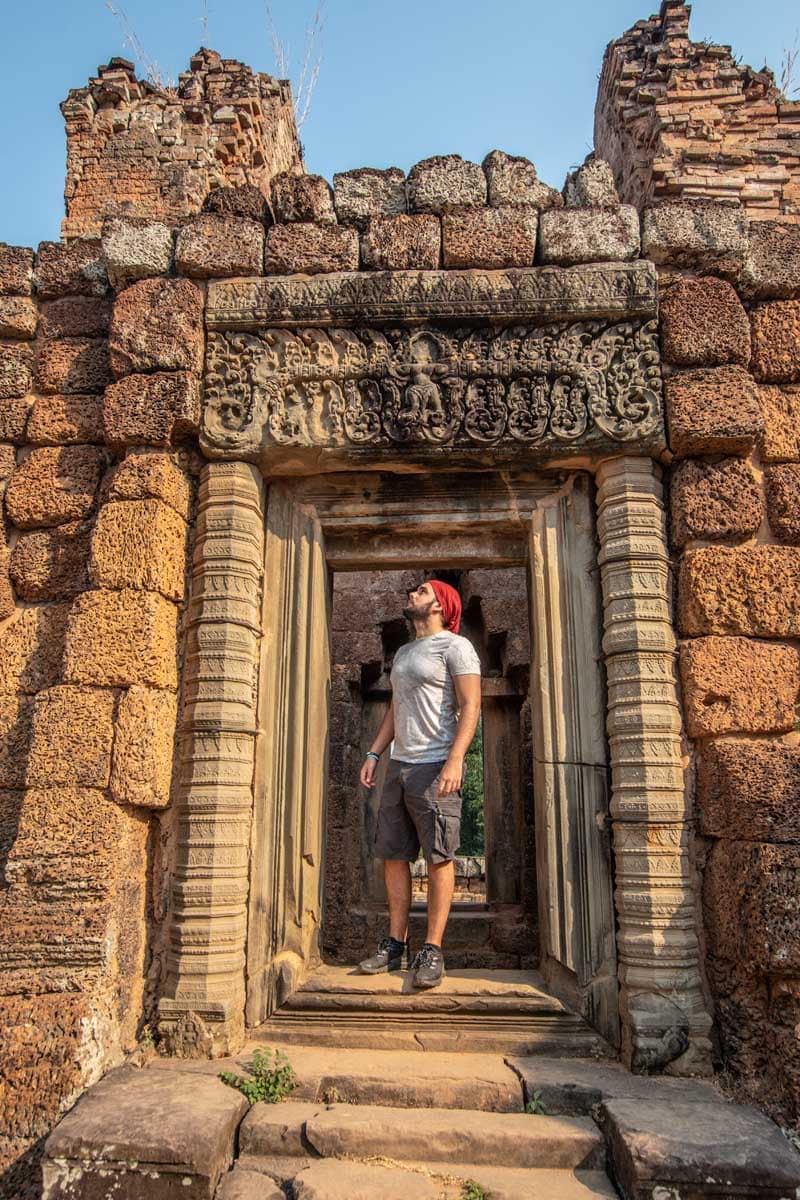
A beautiful 10th-century temple that used to be in the middle of an island, only reachable by boat. The three-layered court of the temple offers various bas-relief ornaments and sculptures.
The top terrace host five sanctuaries, and while the lion protectors on each of their stairways are impressive, the biggest highlight of East Mebon are the four elephant guardians in the corners. The lintels of the sanctuary towers, which are among the best preserved in Angkor, depict exciting stories from the Hindu mythology like Indra riding the three-headed elephant Airavata or the God Skanda on a peacock.
Even though it’s not as big as Ta Keo, East Mebon and its guardian elephants became my favorite pyramid-shaped Siem Reap temple.
7. Thommanon and Chau Say Tevoda
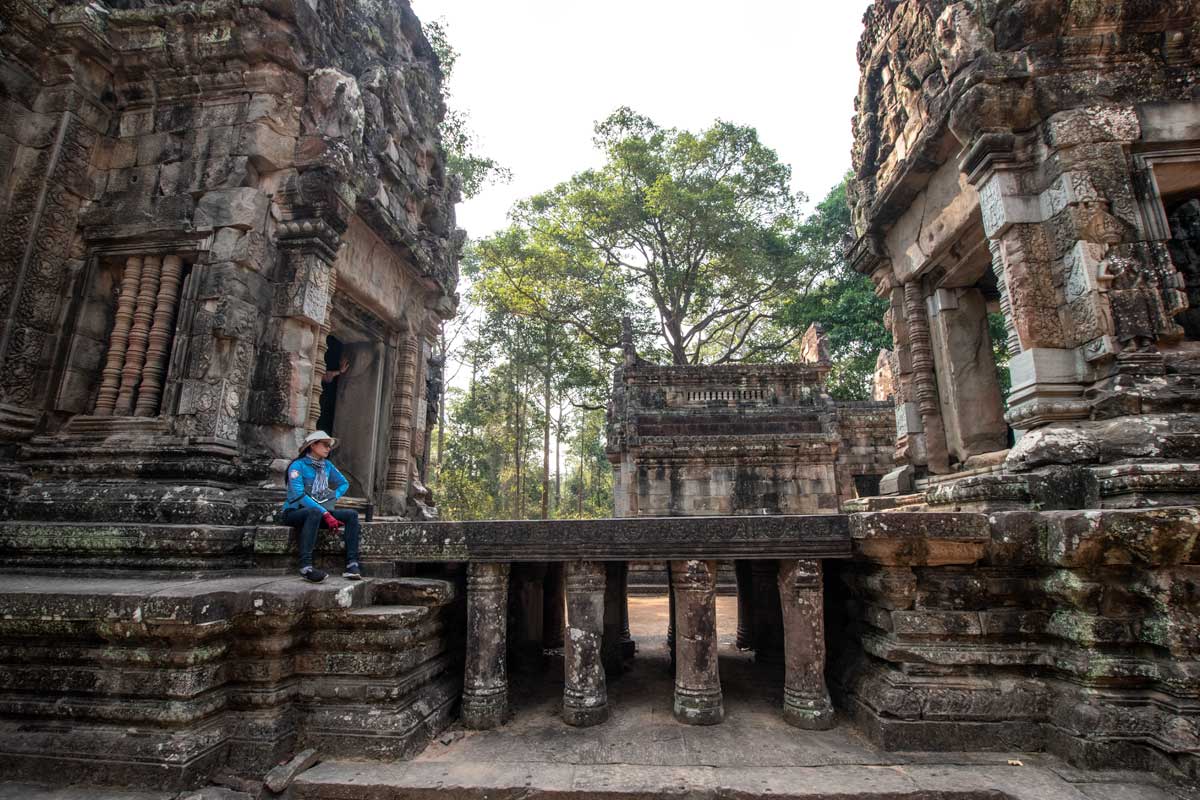

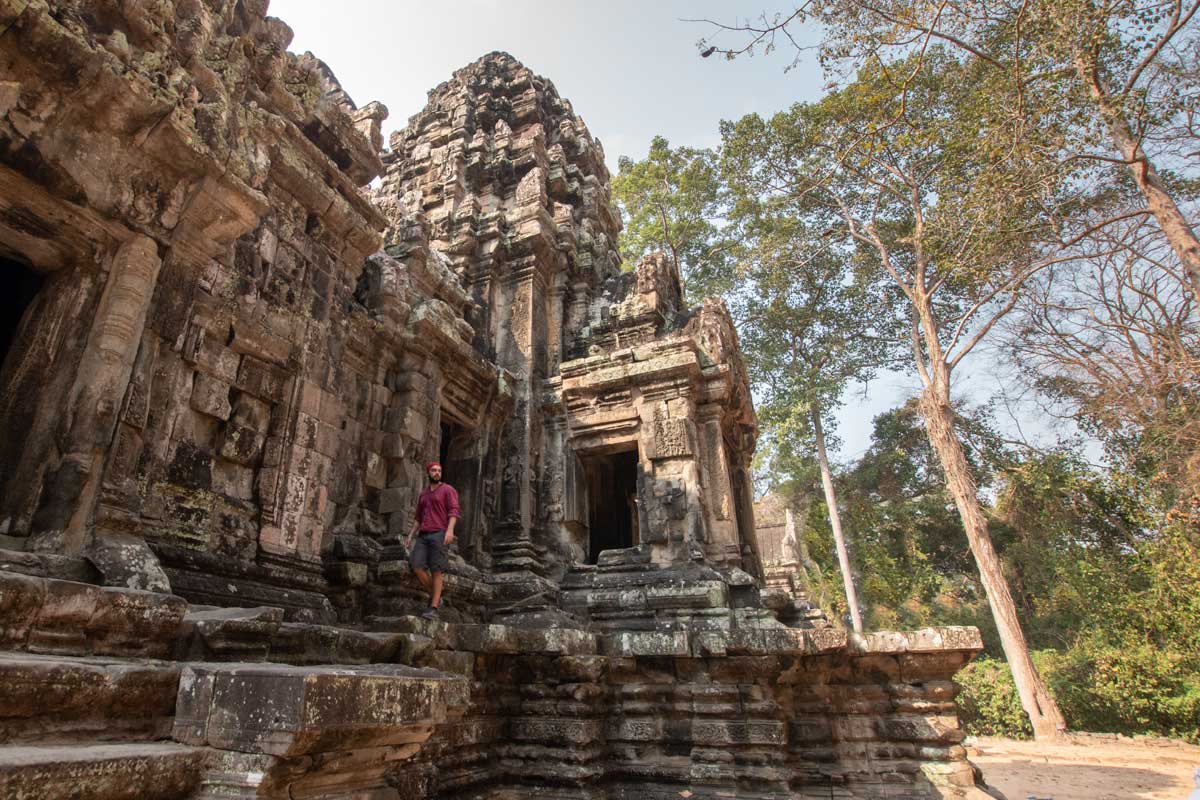
As number seven we have not one but two Siem Reap temples. Since they are quite small and right across each other, they could easily past as one. Don’t be fooled by their size though, Thommanon and Chau Say Tevoda may be small, but they are in excellent condition and offer fantastic photo opportunities.
Thommanon is the older one, built around the time Angkor Wat was built. Besides the shrine, there is also a separate library. The tiny Thommanon is quite a pleasant sight, with all doorways including carved pediments and multiple Devatas (female divine creatures) gracing the walls.
Five hundred meters across Thommanon is the 12th century Chau Say Tevoda temple. Resembling an Indian Odisha temple, Chau Say is built to a cruciform plan and linked to an entrance hall. The highlight of the temple is the small bridge and the carvings that depict episodes from the life of Buddha featuring Garuda and the King of Nagas.
6. Ta Som
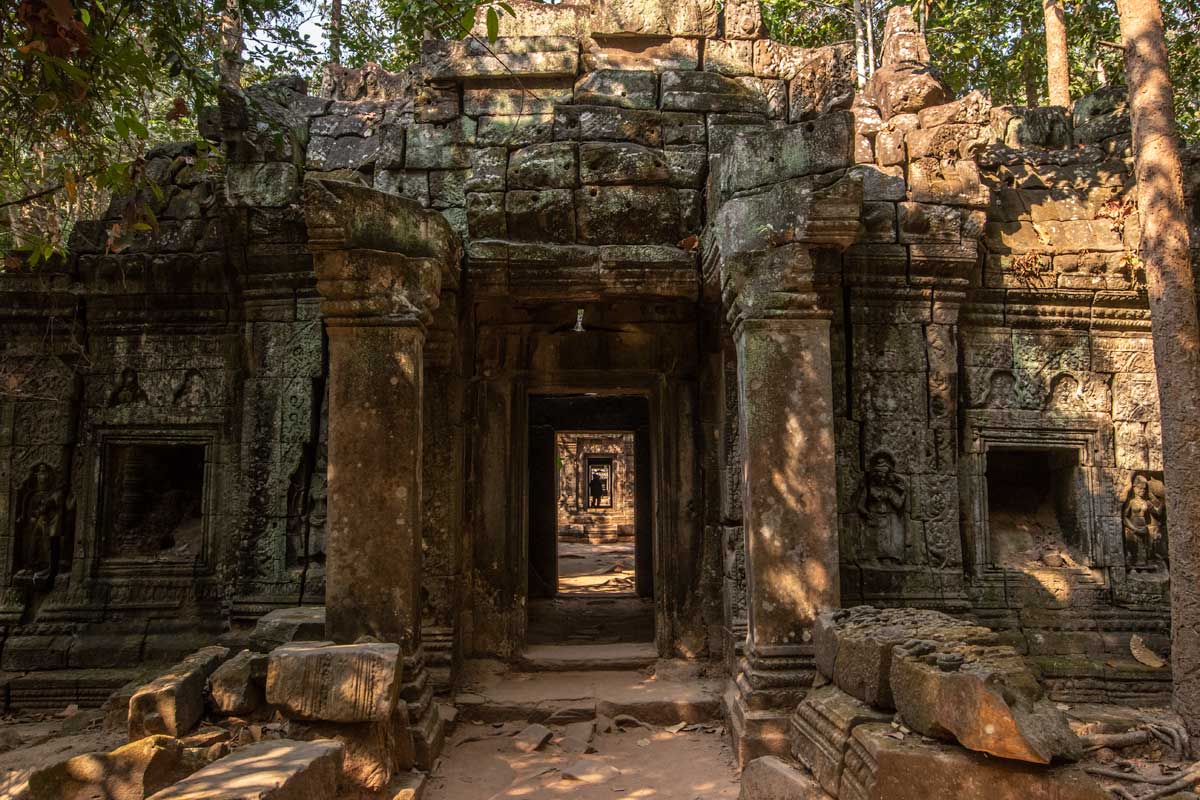
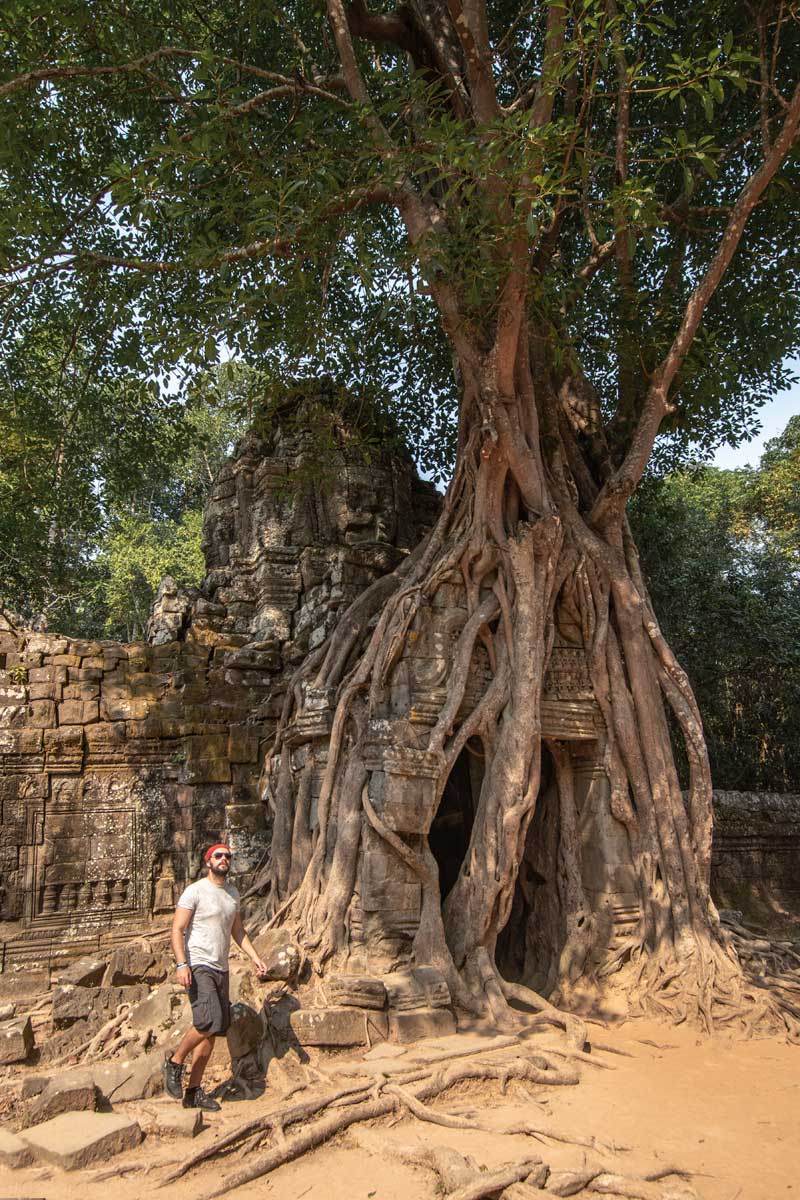
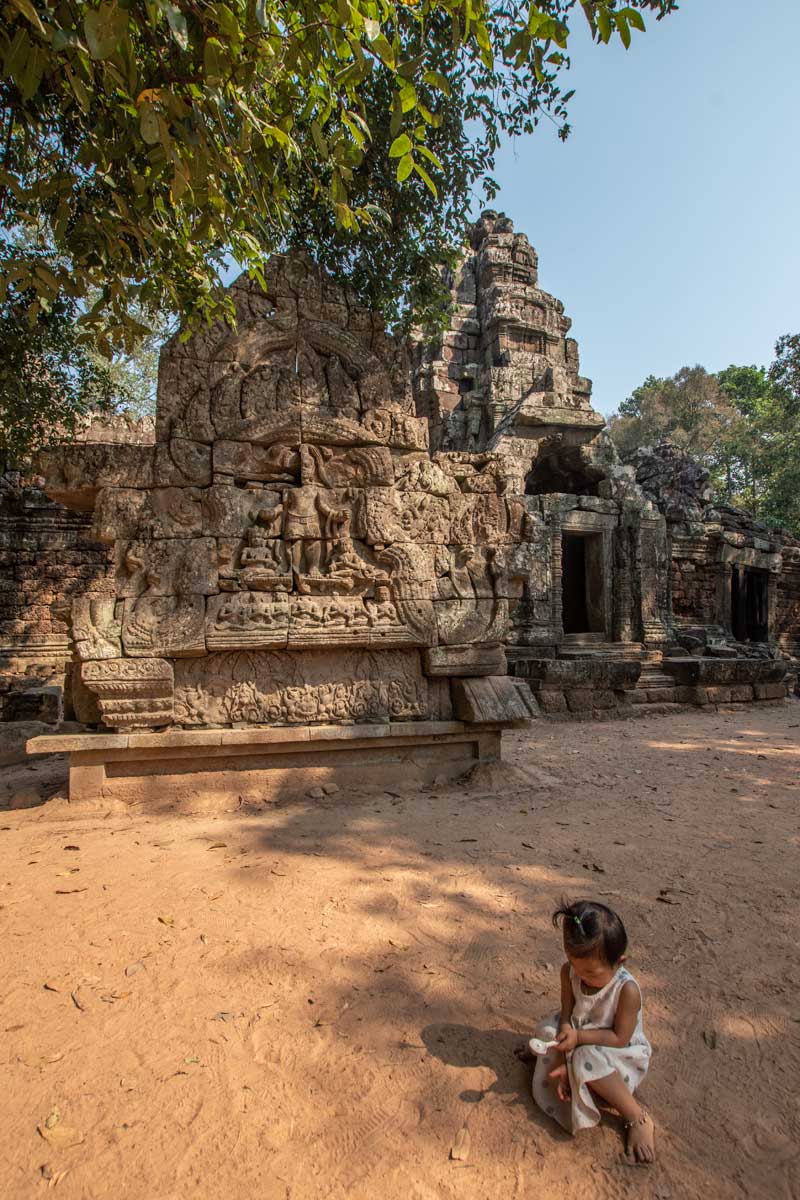
Due to its small size, Ta Som is regularly skipped by the travelers touring the Angkor big circle route. But what a mistake that is! The most underrated Siem Reap temple will greet you with a classical Khmer arc entrance (the one with the smiling face on top) and will lead you to a labyrinth of bas-relief carvings depicting both Hindu and Buddhist images.
Continue to the east gate to find the biggest star of Ta Som – a strangle-fig tree that hugs an ancient gate! Ta Som is not the only place in Angkor to see such a tree, but unlike the more famous Ta Prohm, there won’t be hordes of tourists you have to compete with just to make a single photo.
As they say, the best things come in small packages.
5. Ta Prohm
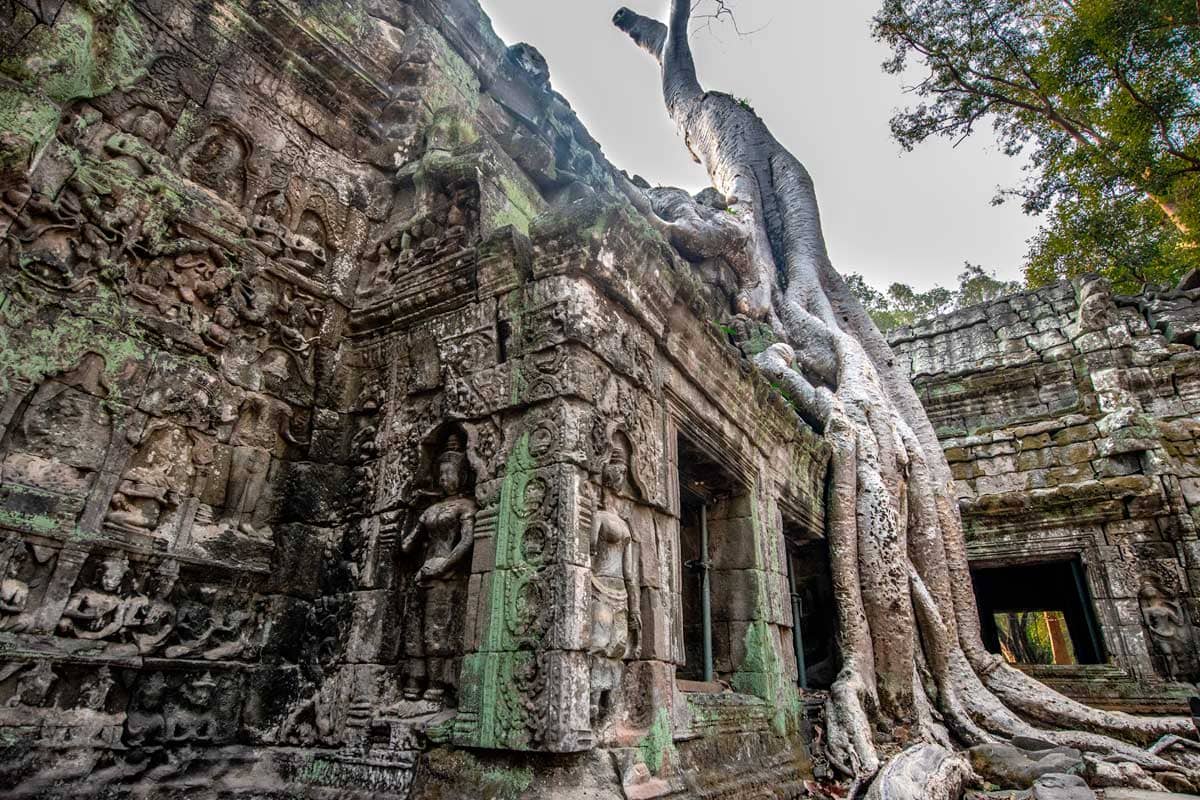


One of the most popular Siem Reap temples, Ta Prohm, is also known as the “Tomb Raider Temple”. It was there that Angelina Jolie chased bad guys in her minuscule shorts giving the temple a serious PR lift.
Built in the 12th century as a Buddhist monastery and center of learning, Ta Prohm follows the typical Khmer structure with a sanctuary centered around the enormous smiling stone face of Prajnaparamita.
The temple was abandoned around the 15th century, after the fall of the Khmer empire. Cambodian jungle wasted no time, and Silk-cotton and Strangler fig trees took root in the lonely stones giving the temple its unique look.
When the Siem Reap temples were rediscovered in the early 20th century, an effort of restoration and preservation began. It was decided, however, that Ta Prohm would be left as it is due to its incredible connection with nature that made him one of the most photogenic and recognizable temples in the world.
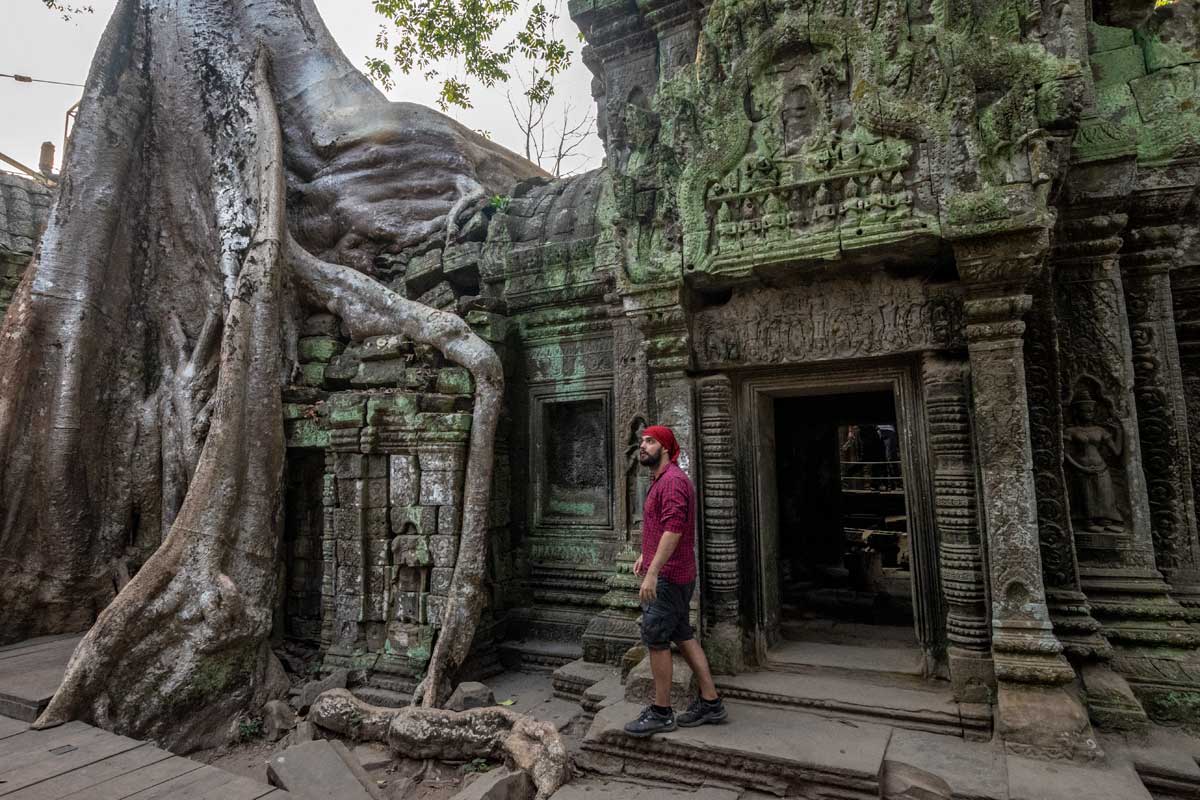
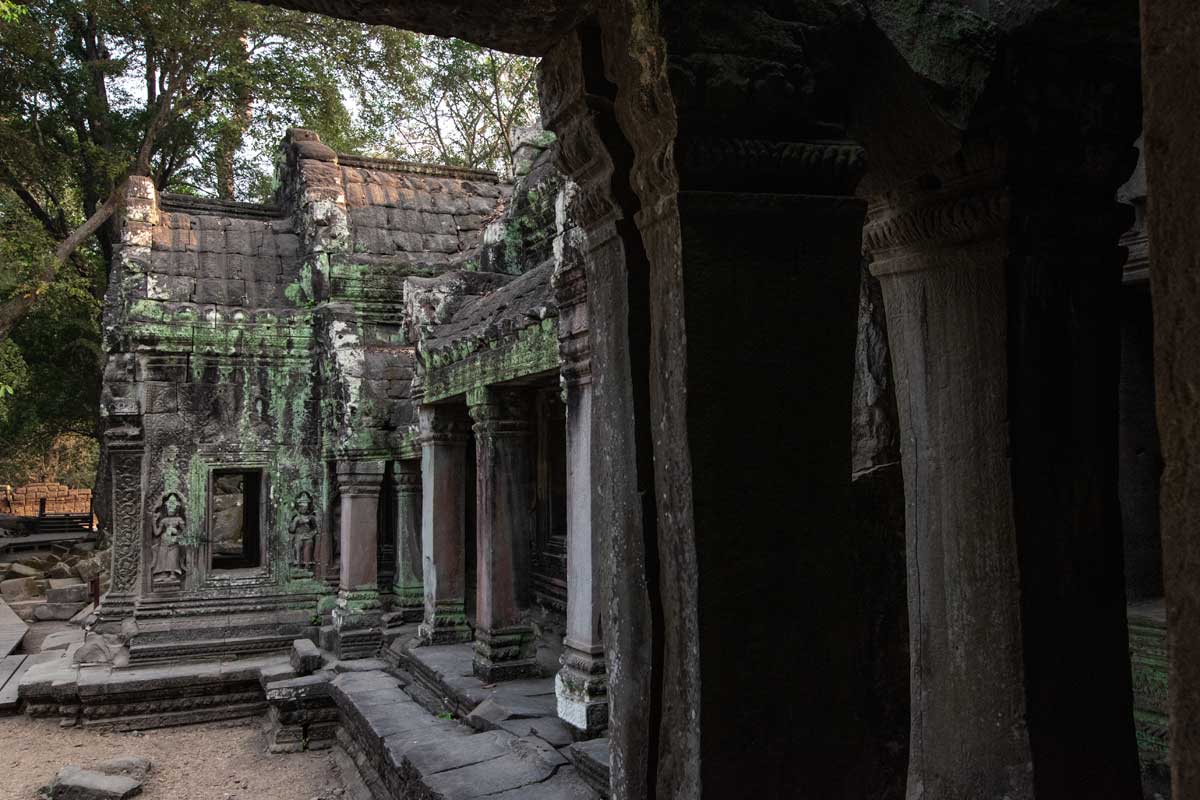
So, why is Ta Prohm only in 5th place? Been as cool as it is and having the Tomb Rider popularity, makes the temple overcrowded. You need to carefully design your Angkor route, just to have a chance to see the monstrous threes without the tourist hordes, and even then you’d probably have to wait on a line to get a photo at the best locations.
Castaway Tip
When you visit the temple, you will find a map with the locations of all giant trees, my advice is – check them all!
4. Banteay Kdei
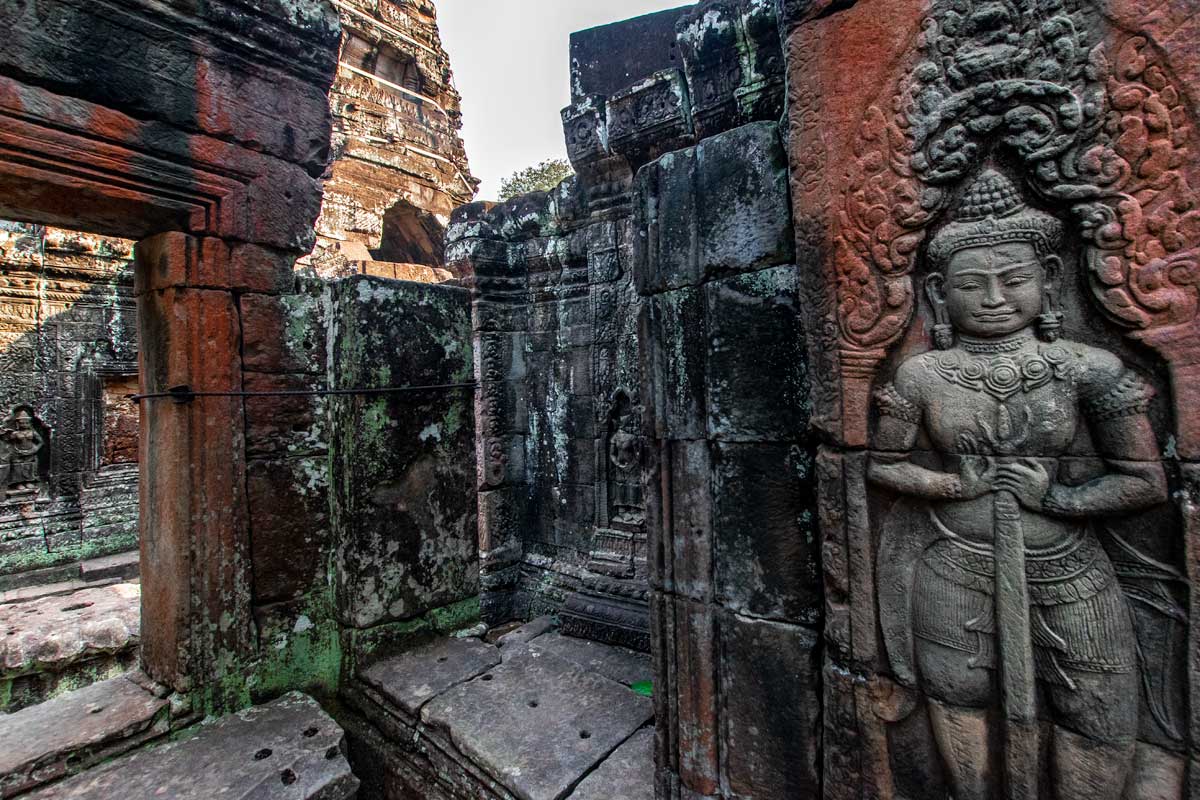
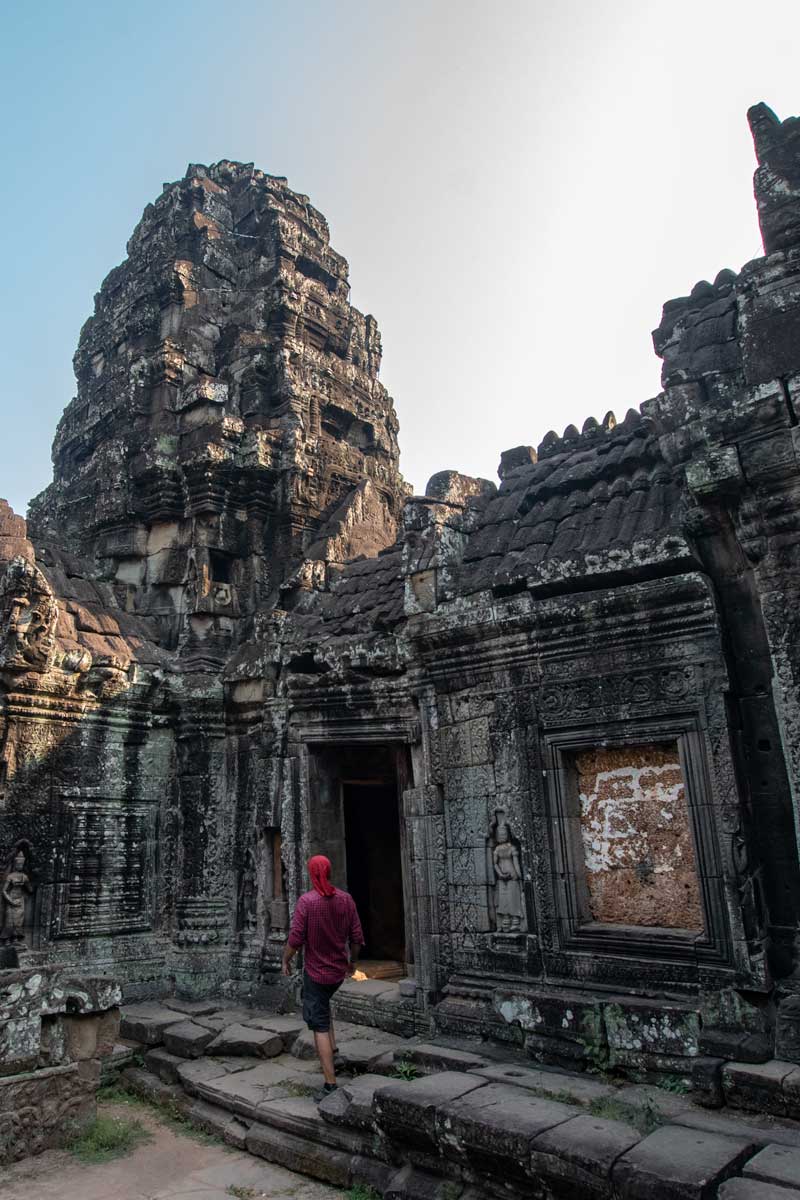

Built in the middle of the 12th century to the beginning of the 13th century, Banteay Kdei is one of the hidden gems of Angkor. Its name translates to “Citadel of Chambers” which is a perfect explanation of the maze of chambers that awaits you there. The medium-sized temple layout consists of three enclosures within an outer compound wall.
There are numerous stunning carvings in the inner enclosure that even though built with an inferior grade of sandstone and construction methods, have been restored to perfection.

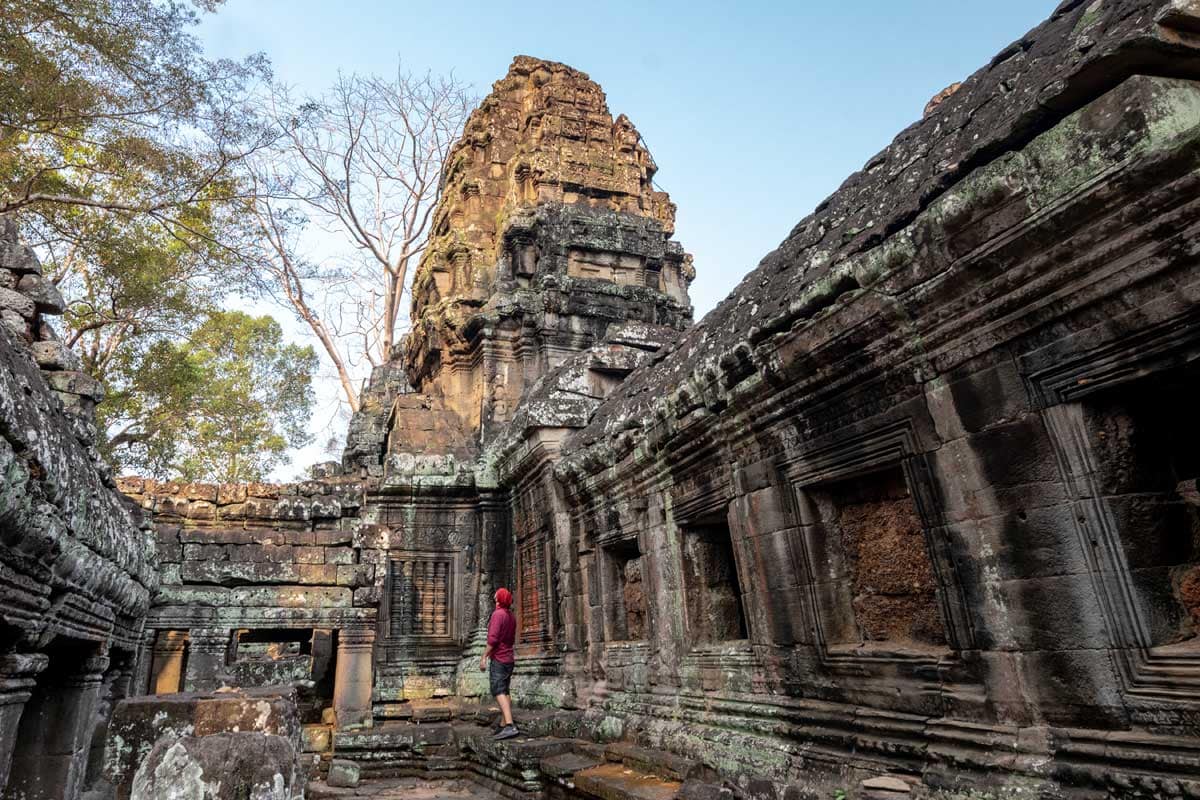
Banteay Kdei is a breath of fresh air compared to the other often overwhelmingly crowded Siem Reap temples. It not only gives you a serene experience of wandering around the mystical labyrinth of its chambers but also presents a bundle of photo opportunities.
3. Preah Khan


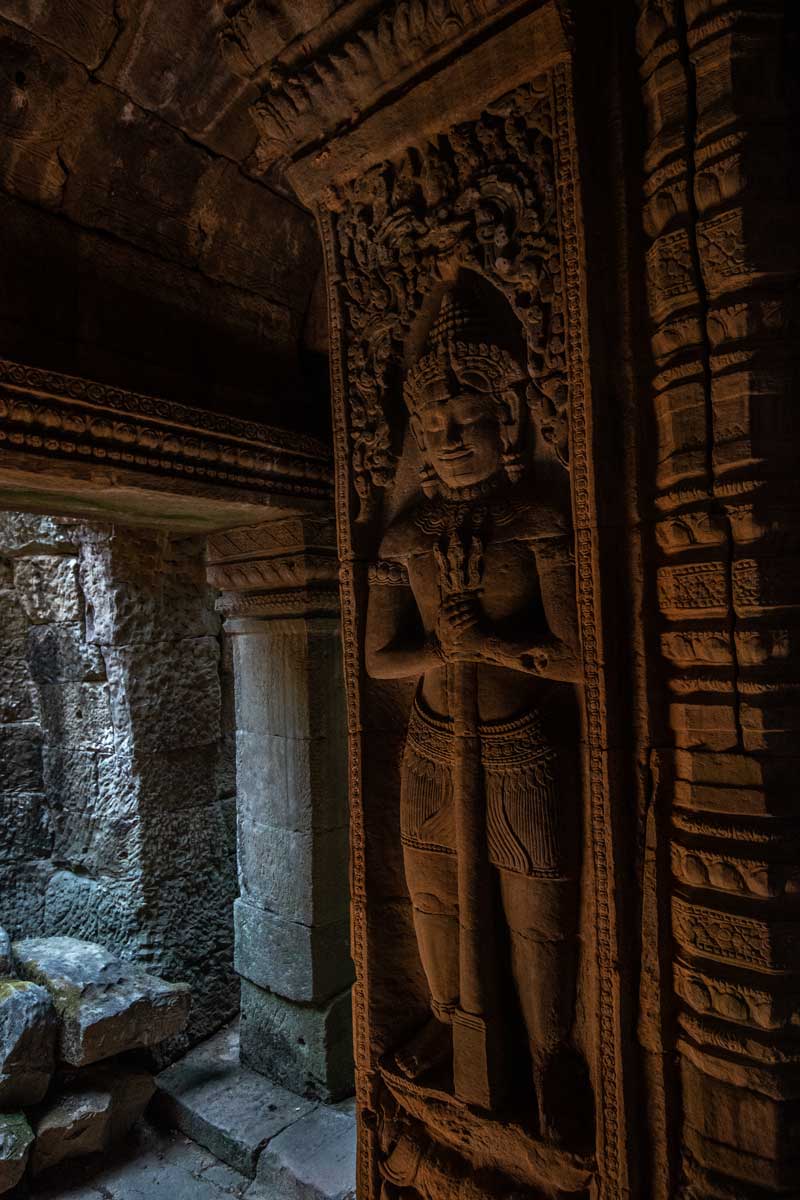
Preah Khan is the one place that took me by surprise. While I expected my number one and two Siem Reap temples to be a spectacle, I’ve never heard of Preah Khan before. My expectations here were non-existent, and I got an unexpected treat.
Built in the 12th century by Jayavarman VII, a Buddhist King who defeated the occupying forces of the Cham, Preah Khan used to be a temple city occupying a large area and surrounded by a moat.
Even though the monument was built as a Buddhist temple, most of the Buddha depictions have been either destroyed or changed into praying Rishi figures.

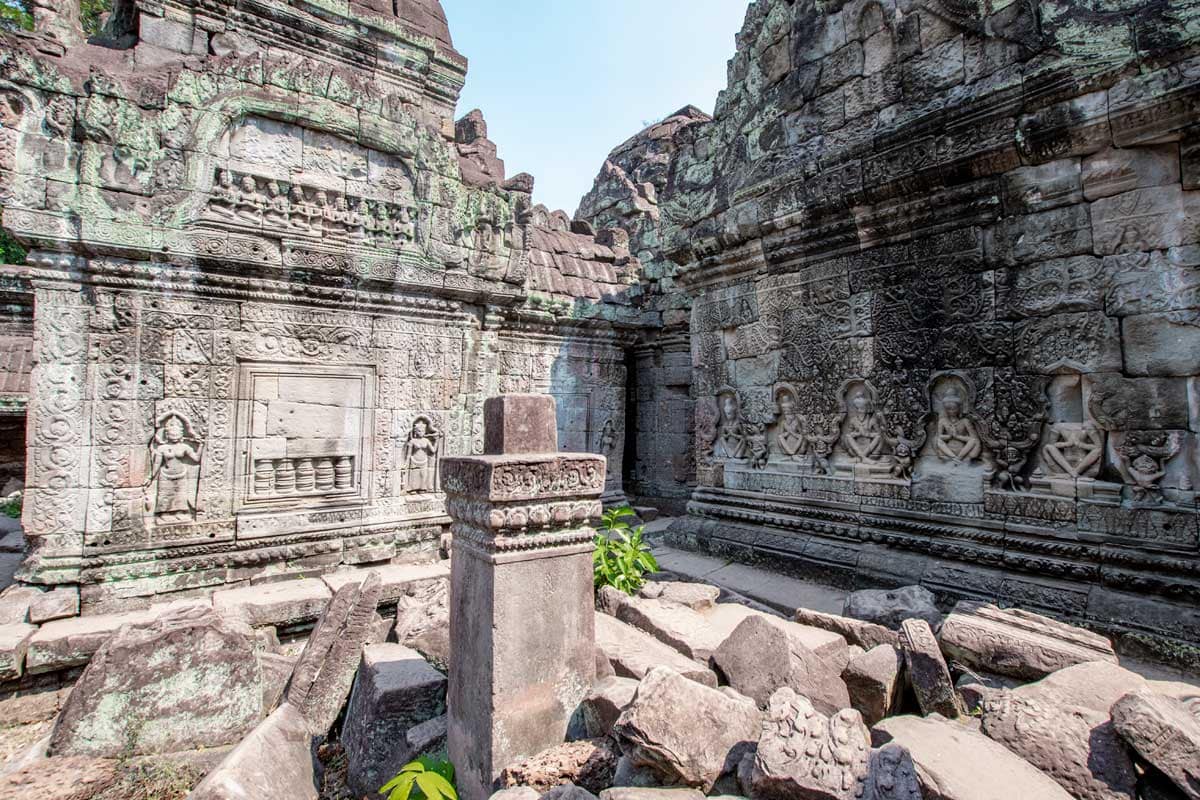
See Also: Visiting Angkor Wat – The Ultimate Guide
As you can imagine, the place is quite big to explore. The temple grounds are divided into four enclosures. The 4th enclosure contained within the moat is over 900 meters long and 750 meters wide. To get to it, you cross a moat bridge that represents a battle between Garudas and the King of Nagas.
The 3rd enclosure consists of three towers with lion guardians and the stunning Hall of Dancers where beautiful devatas are carved above the entrance doors.
The second and inner enclosures are mostly sanctuaries with a big Stupa right in the middle. There you can see some of the Buddha images that somehow managed to survive the Hindu cleansing of the 13th century.
Castaway Fact
In 1939, under a pile of rubble, was found the two meters high Preah Khan stele. Inscribed on all four sides, the stele tells the story of King Jayavarman VII who built the temple and the city around it. The town was named Nagara Jayasri, which translates to “the City of the Sacred Sword” and, according to the stele, 100,000 people were dedicated to serve there!
2. Angkor Thom and Bayon
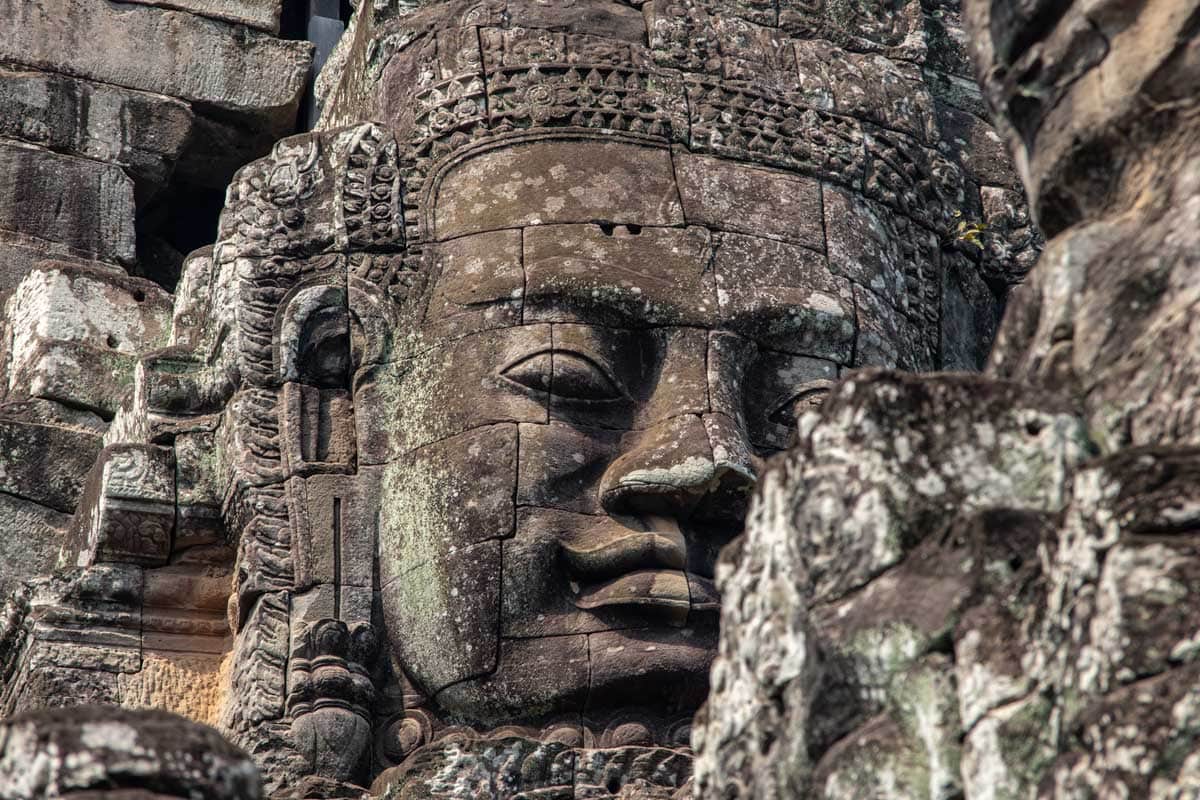

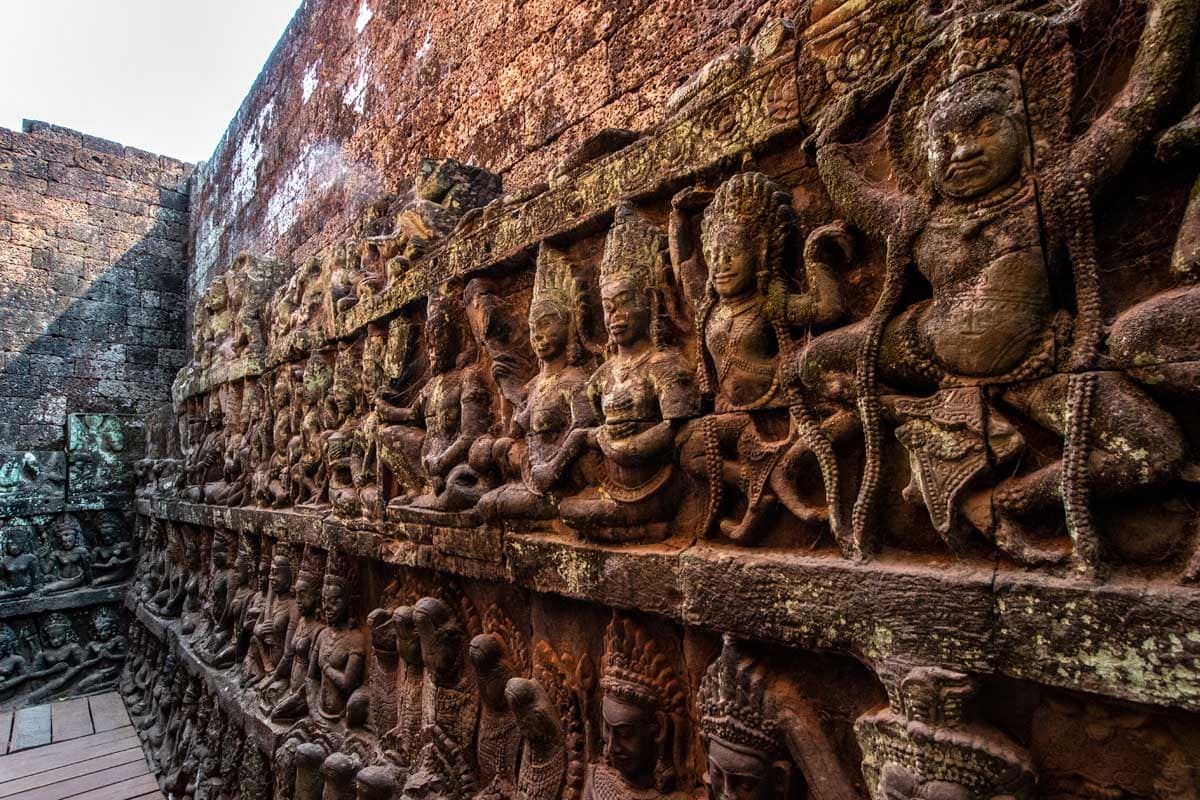
It’s time to get to the heavyweights.
It’s a common mistake to think Angkor Thom is just another Siem Reap temple. It’s not. Angkor Thom is a whole city with multiple temples, terraces, official gates, and even a victory square.
The last capital city of the great Khmer Kingdom was built at the end of the 12th century and covered an area of 10sq km. While most of the buildings (including the King’s palace) were made of wood and didn’t pass the test of time, a lot of the stone structures managed to survive in relatively good condition.
A walk around Angkor Thom starts by going through one of the marvelous smiling-face-gates, continues through the beautifully ornamented Elephant and Leper King terraces, and concludes with temple exploration.


There are three temples in Angkor Thom. While Baphuon and Phimeanakas are older than Angkor Thom itself, the most impressive one by far is Bayon – King Jayavarman VII central temple!

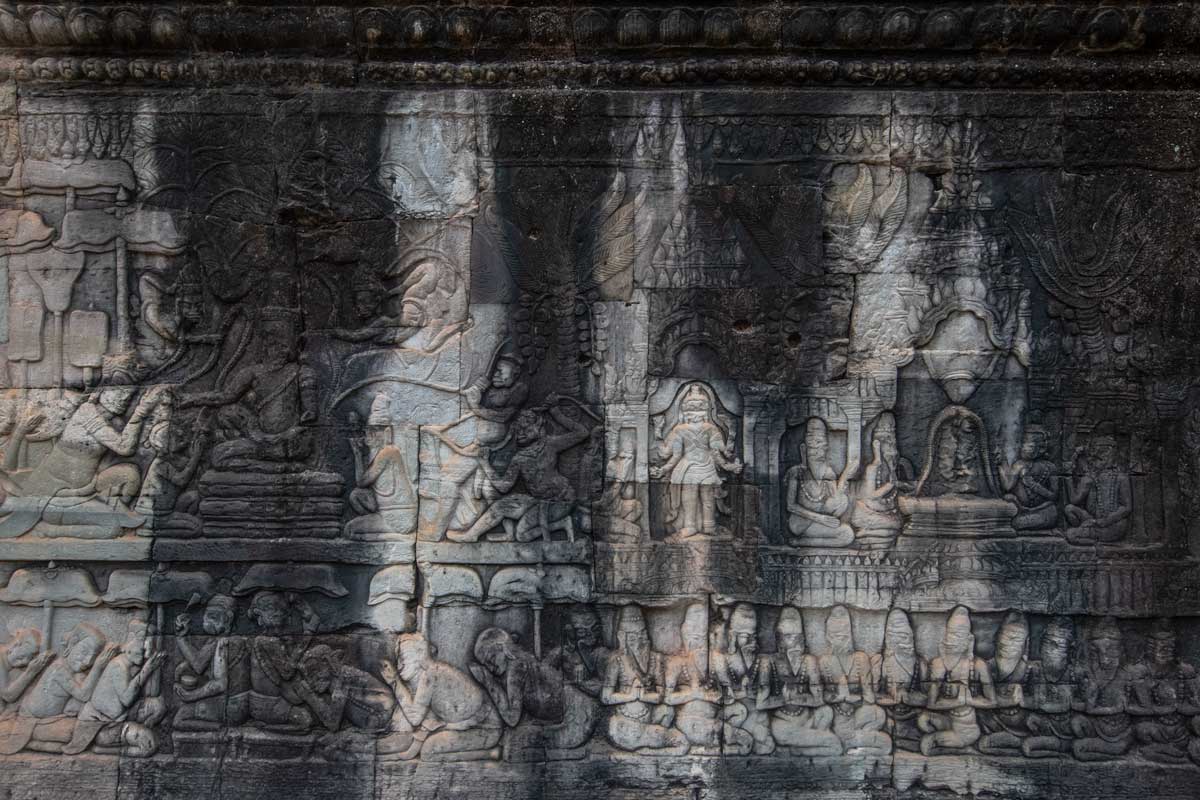
Also known as the “Face Temple”, Bayon and its smiling faces are almost as famous as Angkor Wat. Don’t be disappointed when you glimpse the temple for the first time. From a distance, the absence of outer walls makes Bayon look more like a glorified pile of stones than an ancient piece of art.
Once you go inside though, you’ll start to feel the mystical enchantment of the place. Making your way through the first two levels will show you more than 11 000 bas-relief figures depicting vivid scenes of Khmers’ life, history and mythology. When you reach the upper level, you found yourself inside an open-air circle, surrounded by spiral gothic towers with as many as 54 smiling faces.
Castaway Fact
It’s debatable to whom the faces belong to. Due to most towers having four faces on them, at first, they were believed to represent Brahma, the Hindu God of creation who is often depicted with four heads. Later it was established Bayon is not a Hindu but a Buddhist temple. The leading theory now is that the faces are of Lokeshvara, the Bodhisattva of compassion. According to the local guides, the faces belong to no other but King Jayavarman VII who is smiling to his people!
1. Angkor Wat
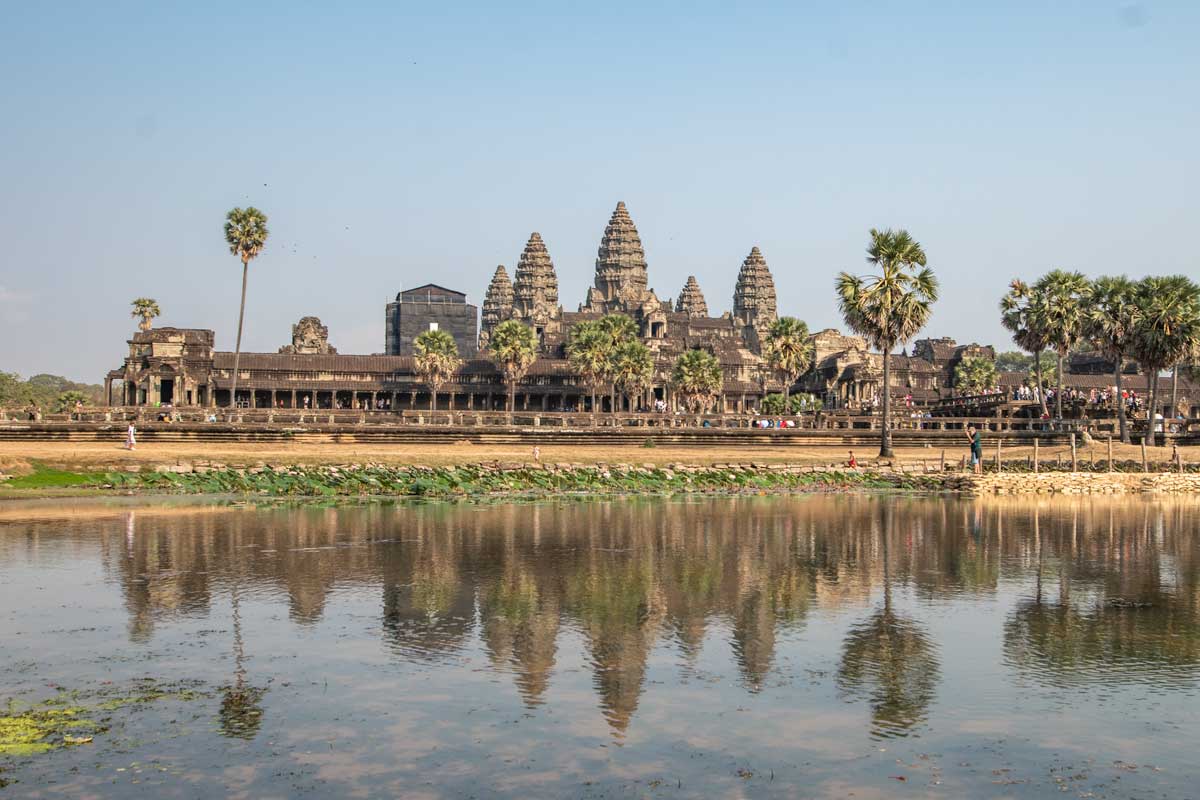
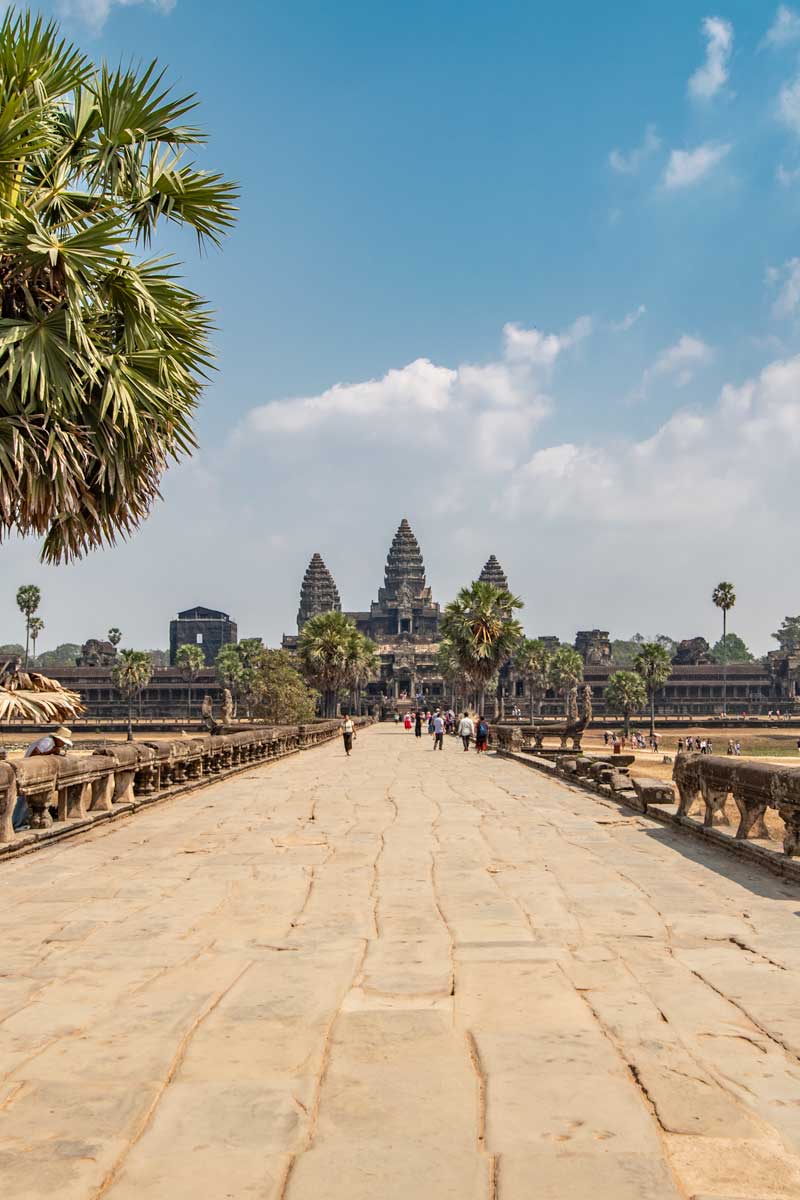
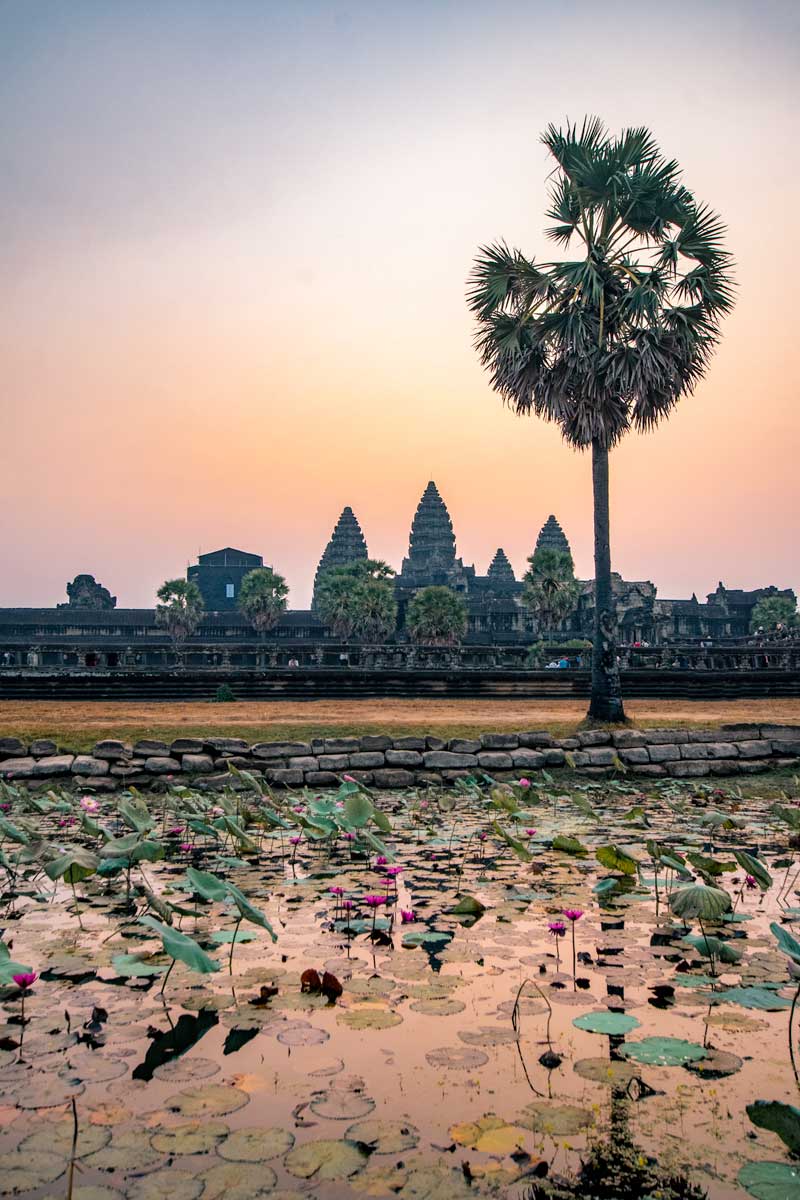
No surprises here. The biggest and most famous monument, the temple that’s a symbol of Cambodia, the one, the only, Angkor Wat!
One of the world’s most astonishing and enduring architectural feats, the mesmerizing beauty of Angkor Wat has stunned every visitor since its discovery in 1860. Built in the 12th century, the monument was initially erected to honor the Hindu god Vishnu but was later transformed into a Buddhist temple.
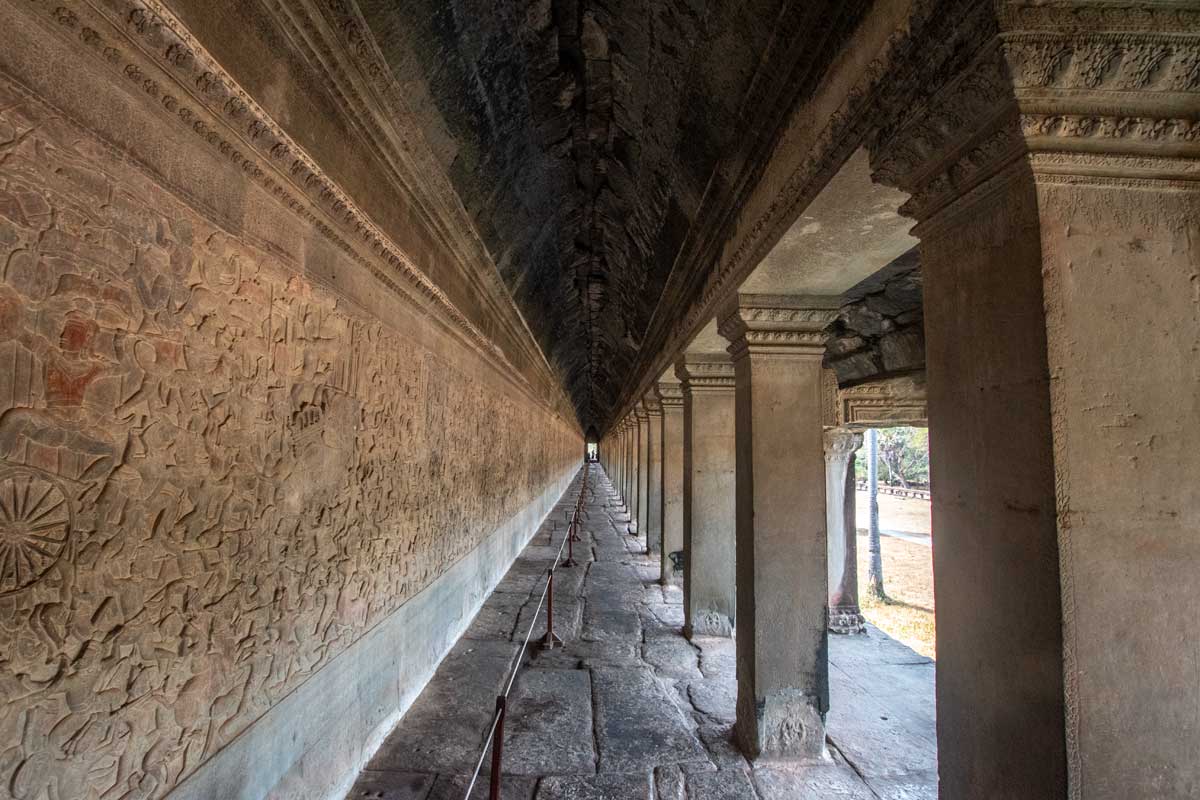
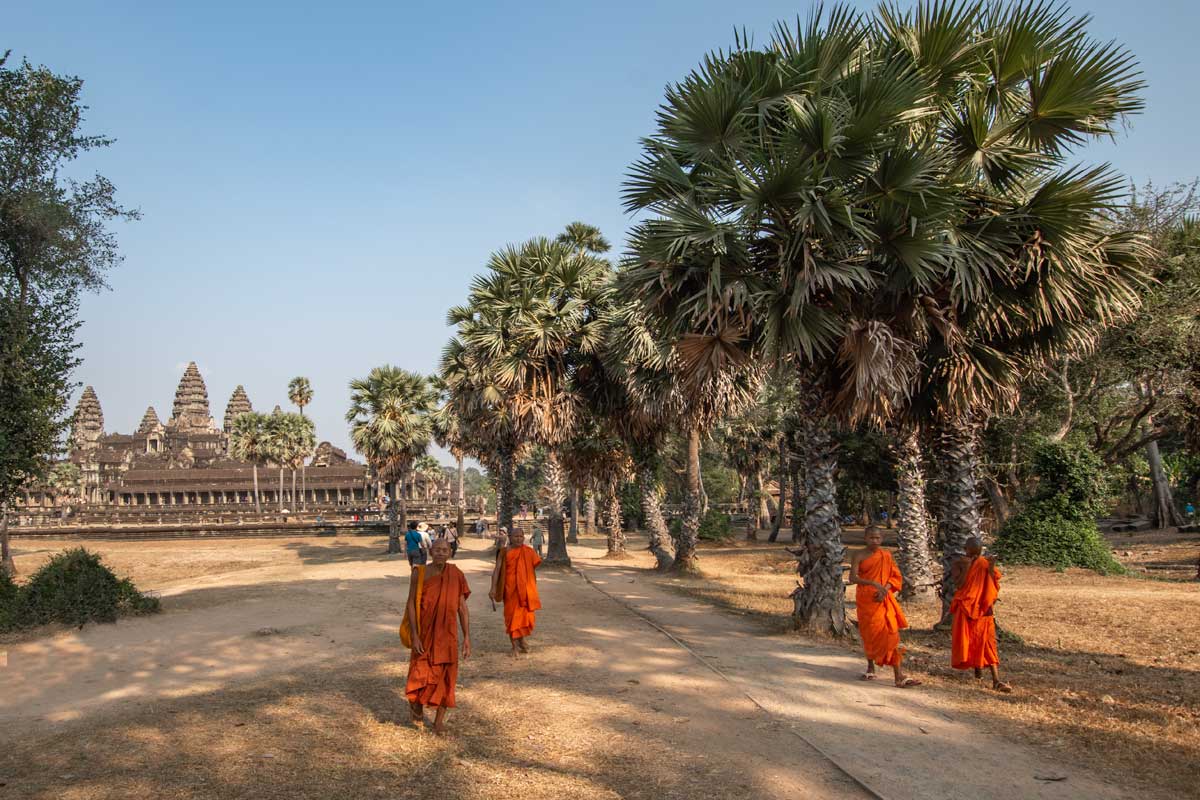
Angkor Wat is the pinnacle of the Khmer architecture. The temple is designed as a miniature replica of the universe. The central tower symbolizes the mythical mountain, Meru (situated at the center of the universe). The five surrounding towers correspond to the peaks of Meru. The outer temple wall symbolizes the edge of the world mountains while the moat represents the oceans beyond.
Out of all Siem Reap temples, Angkor Wat is undoubtedly the most photographed one (especially the sunrise). You must’ve been living under a rock to have never seen at least one photo of the glorious Khmer monument. But no picture can prepare you for the unraveled beauty of the grand temple.
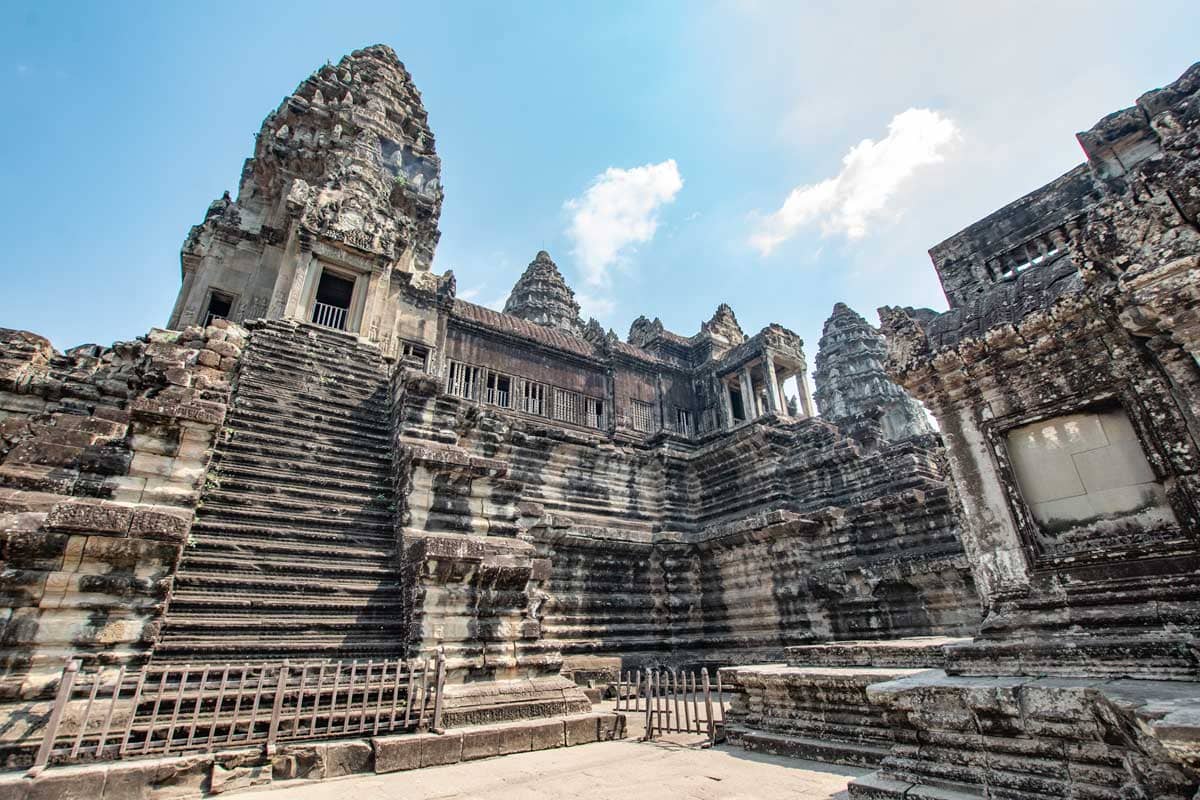
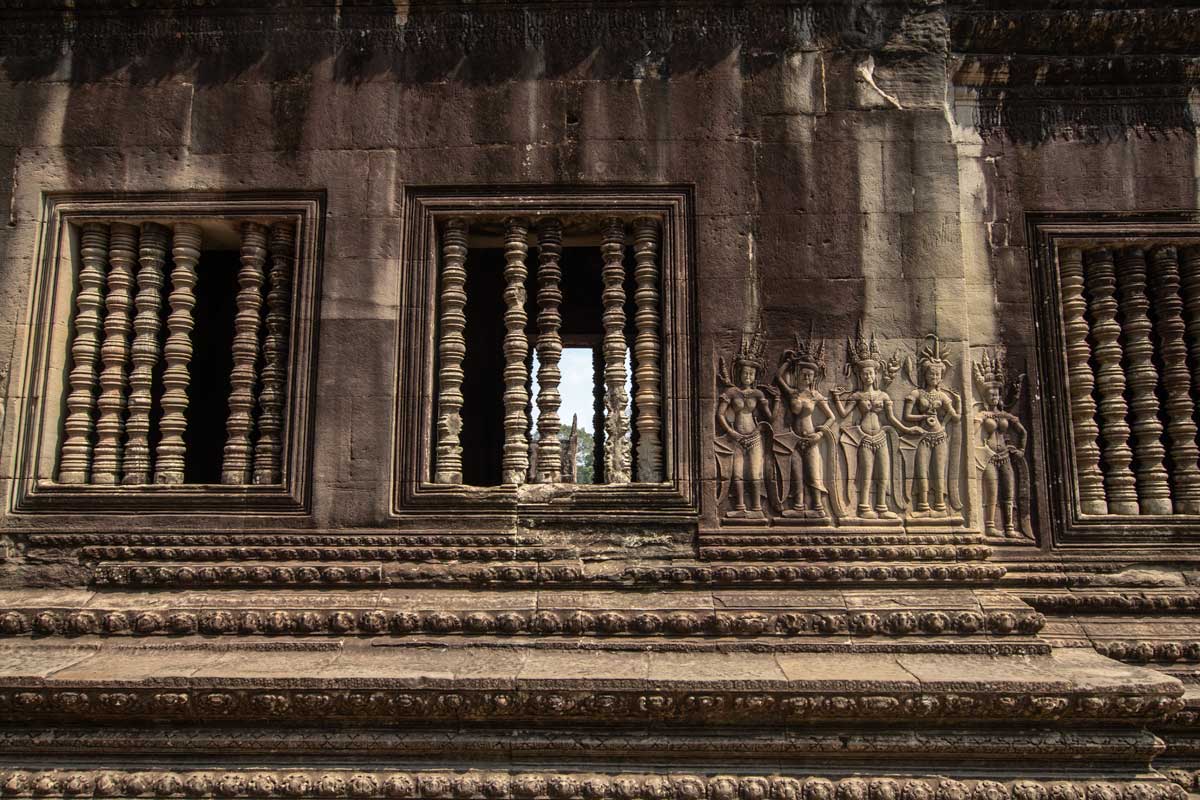
When Henri Mouhot found Angkor Wat he wrote: “One of these temples – a rival to that of Solomon and erected by some ancient Michelangelo might take an honorable place beside our most beautiful buildings” and I believe his words stand true, even for the 21st-century standards.
From its towers raised as lotus flowers reaching for the heavens to the endless corridors carved with the longest bas-reliefs in the world, Angkor Wat most certainly deserves its reputation as the 8th Wonder of the World!
Castaway Fact
The naturalist, Henri Mouhot rediscovered Angkor Wat by accident. He was in Cambodia to study the local insects when he stumbled upon the glorious monument. Unfortunately for him, he didn’t have a lot of time to enjoy its achievement. He died just a year after the discovery, bitten by a poisonous insect.
That’s all from me, I hope you enjoyed this virtual tour of the best Siem Reap temples.
————————————
If you haven’t planned your trip there yet, find out how I plan my trips!
————————————
I have 11 bucket list ideas for Cambodia. See my impossible bucket list of 1700+ adventures!
Which Siem Reap temple is your favorite?
Some of the above are affiliate links and I will earn a percentage of the sale if you purchase through them at no extra cost to you. This helps keep my site running – so thanks in advance for your support!

